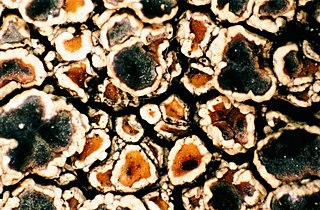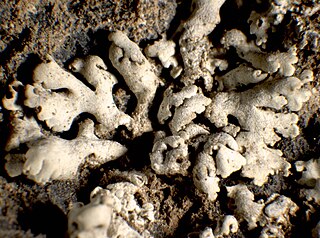
Aspicilia is a genus of mostly crustose areolate lichens that grow on rock. Most members have black apothecia discs that are slightly immersed in the areolas, hence the common name"Given the same reason, the naming of Aspicilia is derived from the Greek word for "shield concave".

Megasporaceae are a family of fungi belonging to the order Pertusariales. Taxa are lichenized with green algae, and grow on rocks, often in maritime climates close to fresh water. Phylogenetic analysis has shown that this family is related to the Pertusariaceae, another family of lichens. The genus Aspicilia was moved here from the Hymeneliaceae.

The Pertusariales are an order of fungi in the class Lecanoromycetes, comprising 8 families, 31 genera, and over 600 species, many of which form lichens. This diverse group is characterized by complex taxonomic history and ongoing phylogenetic revisions. Originally proposed by Maurice Choisy in 1949 and later formally published by the lichenologists David L. Hawksworth and Ove Eriksson in 1986, Pertusariales has undergone significant reclassification due to molecular phylogenetics studies. The order includes well-known genera such as Pertusaria and Ochrolechia, as well as families like Megasporaceae and Icmadophilaceae.

Diploschistes is a genus of lichen-forming fungi in the family Graphidaceae. Commonly known as crater lichens, members of the genus are crustose lichens with a thick, cracked (areolate) body (thallus) with worldwide distribution. The fruiting part (apothecia) are immersed in the thick thallus so as to have the appearance of being small "craters". The widespread genus contains about 43 species.

Circinaria is a genus of crustose lichens in the family Megasporaceae. It was circumscribed by Johann Heinrich Friedrich Link in 1809.

Megaspora is a genus of lichen-forming fungi in the family Megasporaceae. It contains four species of crustose lichens that typically grow on soil, bryophytes, or plant litter on chalky substrates.
Baidera is a single-species fungal genus in the family Roccellaceae. It contains the species Baidera mauritiana, a corticolous (bark-dwelling), crustose lichen found in Mauritius. Both the genus and species were described as new to science in 2020 by Paul Diederich and Damien Ernst. The genus name honours Cláudia Baider, curator of the Mauritius Herbarium.
Calopadia saxicola is a species of saxicolous (rock-dwelling) crustose lichen in the family Pilocarpaceae. It is found on the rocky shores of southern Brazil, where it thrives in the shade of vegetated zones and grows directly on rocks away from other crustose lichens. The lichen was formally described as a new species in 2015. Calopadia saxicola stands out from its close relatives due to its well-defined thallus, reddish-brown disc, thicker hymenium, and smaller conidia.
Circinaria mansourii is a species of terricolous (ground-dwelling) crustose lichen in the family Megasporaceae. It is primarily found on soil or plant debris in Iran, particularly in the mountainous steppe-like habitats. It was described as new to science in 2011.
Protothelenella is a genus of fungi in the family Protothelenellaceae. It contains 11 species, some of which form lichens. Protothelenella species have a crustose thallus with spherical to pear-shaped, dark brown to blackish perithecia. Microscopic characteristics of the genus include bitunicate asci with an amyloid tholus, and ascospores that are colourless and contain multiple internal partitions. Some species grow on acidic substrates including rocks, soil, bryophytes, plant detritus or rotten wood. Other species are lichenicolous (lichen-dwelling), growing on species of Solorina, Peltigera, Pseudocyphellaria, or Cladonia.
Schaereria porpidioides is a species of saxicolous (rock-dwelling), crustose lichen in the family Schaereriaceae. It is found in the Falkland Islands.
Pyrenodesmia micromarina is a species of saxicolous (rock-dwelling), crustose lichen in the family Teloschistaceae. It is found in the Eastern Mediterranean, specifically along the coasts of the Black Sea and the Sea of Marmara in Russia, Turkey, and Ukraine. It grows on coastal rocks and occasionally concrete, often in Mediterranean scrub vegetation.
Filsoniana ferdinandmuelleri is a species of saxicolous (rock-dwelling), crustose lichen in the family Teloschistaceae. It is found in Australia. The lichen has a squamulose (scaly) thallus, with a range of bright yellow to greenish-yellow and brownish-orange colours in its soredia and apothecia, respectively. The areoles of this lichen are varied in size, slightly raised from the thallus surface, and each carries one to four apothecia. The soralia are rounded or irregularly shaped, covering most of the thallus surface as a yellow to greenish-yellow mass. The apothecia have dark brownish-orange discs, surrounded by slightly paler yellow margins, with the spore-bearing asci containing typically eight brownish-golden ascospores.
Marchantiana occidentalis is a species of corticolous and saxicolous, crustose lichen in the family Teloschistaceae. It is found in Western Australia, usually as an inhabitant of dry twigs, bark, or wood of various plant species, but occasionally on granite rock outcrops. It forms a well-developed thallus, shiny and composed of tiny dark greenish to brown areoles, with sizes typically ranging from 5–15 mm, though larger aggregations are possible. It features numerous rounded apothecia scattered across its surface, varying in form and colour, with a distinct margin and disc.

Physcia magnussonii is a species of saxicolous (rock-dwelling), foliose lichen in the family Physciaceae. It was formally described as a new species in 1952 by the Swiss botanist Eduard Frey. He collected the type specimen in Bern, Switzerland. The species epithet honours the Swedish lichenologist Adolf Hugo Magnusson. Frey's original specimen was later declared the lectotype of the species by Roland Moberg in a 1977 monograph on the genus Physcia.

Mangoldia is a genus of lichen-forming fungi in the subfamily Graphidoideae of the family Graphidaceae. It contains four species of corticolous (bark-dwelling) script lichens.
Melanotopelia is a genus of lichen-forming fungi in the family Graphidaceae. It has four species of corticolous (bark-dwelling), crustose lichens. This genus includes species characterised by dark pigmentation in their exciple, non-amyloid ascospores, and specific secondary metabolites.
Pyrenula fusoluminata is a species of corticolous (bark-dwelling), crustose lichen in the family Pyrenulaceae, described as a new species in 2002. Found in the forests of Minas Gerais, Brazil, this species is distinguished by its unique spindle-shaped ascospores, which are more than four times as long than they are wide.
Sparria is a small genus of lichen-forming fungi in the family Opegraphaceae.

Aspiciliella is a genus of lichen-forming fungi in the family Megasporaceae. It has four species. The genus is characterised by its crustose, rimose-areolate thallus that is partially continuous and has a K+ (red) reaction. The epihymenium is typically green to olive-green and turns light green when treated with N. Aspiciliella has eight-spored asci of the Aspicilia-type, containing ellipsoid, colourless, and simple ascospores.








